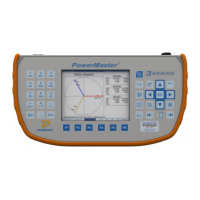Testing Tips:
1. Verify the probe is rated for the voltage and current being tested. Only use probes
meeting the manufacturer’s specifications. Using probes that do not meet the
manufacturer’s specifications may lead to a safety hazard.
2. Never connect a current probe around a conductor before terminating it to its cable and to
the PowerMaster
®
.
3. For LiteWire probes, verify the optic cable is clean to prevent surface arcing.
4. Position the probe head perpendicular to the current carrying conductor as nearly in the
center of the probe opening as practical.
5. For clamp-on probes, clean contact surfaces and then snap and release the jaws to verify
a metal-to-metal contact of the jaws (dirt and grease may contaminate the surfaces.)
6. For flexible probes, the plastic closure connector should be fully closed and be positioned
as far as possible from the conductor (also observe #7 below).
7. Position the probe as far as practical from other current carrying conductors. (All current
probes will respond to external currents.)
8. For LiteWire probes, press the black button 2x on the head assembly to force the 2000A
range when currents are above 100 amps. (Note that the decimal is not displayed on the
receiver unit when the 2000A range is active.)
9. For LiteWire probes, position the open end such that it is not pointing toward other current
carrying conductors.
10. IN GENERAL, if a CT Ratio test has an erroneous ratio result or a phase angle greater
than ±1°, check the installation of the current probe before suspecting a CT problem.
Rev 1.5 87

